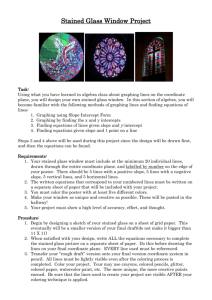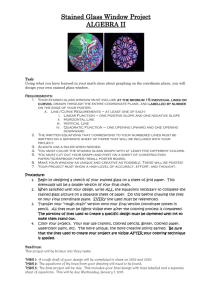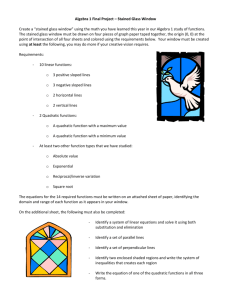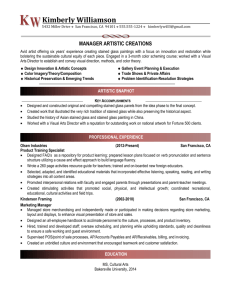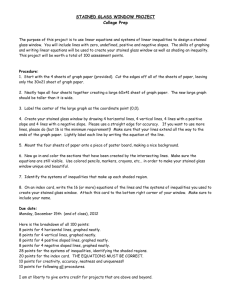Detailed Lesson Plan_ GSU Format
advertisement
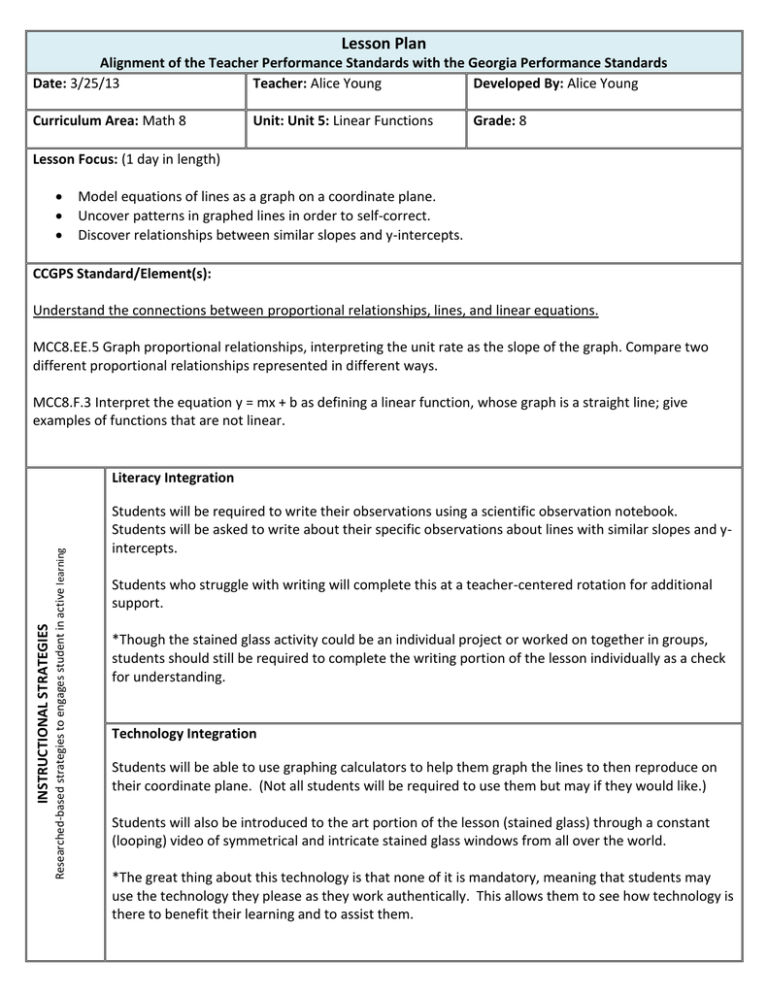
Lesson Plan Alignment of the Teacher Performance Standards with the Georgia Performance Standards Date: 3/25/13 Teacher: Alice Young Developed By: Alice Young Curriculum Area: Math 8 Unit: Unit 5: Linear Functions Grade: 8 Lesson Focus: (1 day in length) Model equations of lines as a graph on a coordinate plane. Uncover patterns in graphed lines in order to self-correct. Discover relationships between similar slopes and y-intercepts. CCGPS Standard/Element(s): Understand the connections between proportional relationships, lines, and linear equations. MCC8.EE.5 Graph proportional relationships, interpreting the unit rate as the slope of the graph. Compare two different proportional relationships represented in different ways. MCC8.F.3 Interpret the equation y = mx + b as defining a linear function, whose graph is a straight line; give examples of functions that are not linear. INSTRUCTIONAL STRATEGIES Researched-based strategies to engages student in active learning Literacy Integration Students will be required to write their observations using a scientific observation notebook. Students will be asked to write about their specific observations about lines with similar slopes and yintercepts. Students who struggle with writing will complete this at a teacher-centered rotation for additional support. *Though the stained glass activity could be an individual project or worked on together in groups, students should still be required to complete the writing portion of the lesson individually as a check for understanding. Technology Integration Students will be able to use graphing calculators to help them graph the lines to then reproduce on their coordinate plane. (Not all students will be required to use them but may if they would like.) Students will also be introduced to the art portion of the lesson (stained glass) through a constant (looping) video of symmetrical and intricate stained glass windows from all over the world. *The great thing about this technology is that none of it is mandatory, meaning that students may use the technology they please as they work authentically. This allows them to see how technology is there to benefit their learning and to assist them. Component 1: Teacher and students talk about what they will learn and do (Communication of Learning Intentions) Objective: By the end of this lesson, students will be able to create a symmetrical stained glass window from a set of linear equations and be able to understand and discuss what aspects of the equations make the art work symmetrical. Essential Question: How can I determine what parts of an equation can be manipulated to create a symmetrical stained glass window? Communication to Students: The objective for the day will be written on the board for constant reference and will be verbally introduced to the students at the beginning of the lesson. The essential question will also be on a looping banner at the top of the promethean board, catching their attention and keeping the essential question relevant. OPENING Getting students ready to learn Component 2: How will you know when they have learned it? (Communication of Success Criteria) The student will be able to independently create a successfully symmetrical stained glass window while also communicating their understanding of parallel slopes through a detailed written explanation. Component 3: Activating Approach/Warm Up/Engagement (Build Commitment and Engagement): Students will watch a video of historical stained glass windows that emphasize the importance of mathematical structure and symmetrical structure. Students will be engaged by the technology, use of integration with other subjects (history, art, architecture). Component 4: Give students new information (Teacher Presentation Strategies-includes Academic Vocabulary) Teacher will open the lesson by reviewing the vocabulary relating to the equation y = mx + b. Students will complete a card sort in groups with the different vocabulary words to sort into groups. (Words will include: slope, y-intercept, axis, rate of change, rise, run, coordinate point, etc.) Component 4: Give students new information (Teacher Presentation Strategies, Procedures, Exploration) Teacher will continue to open the lesson by reviewing how to graph a line from an equation in y = mx + b form. Teacher will model how to graph 4 equations using the Promethean board: 1. Y = 2/3x – 5 (fractional slope and negative intercept) 2. Y = 4x + 1 (whole number slope and positive intercept) 3. Y = -x + 4 (no visible slope) 4. Y = 2x (no visible y-intercept) WORK PERIOD Providing Rigor and Differentiation Releasing students to do the work CHALLENGE AND DIFFERENTIATION Critical Thinking and Extension Questions (Differentiation and Academically Challenging Environment) Extension question: Write about and model on graph paper the effect of the equation on perpendicular lines, not just parallel lines. What parts of the equation are different and the same? Critical Thinking Additional Directions: Advanced and accelerated students will be able to do an extension activity (or modify the original activity) where the students create their own equations that will add on to the stained glass window to continue to produce symmetrical line results. Supporting Student Learning (Scaffolding and Accelerating Learning for Different Ability Levels) Scaffolding: 1. Low learners: Students will work at the teacher-center to complete the activity. 2. Emergers: Students will be allowed to work together to produce individual results on paper. 3. Advanced and accelerated: Students will be able to add on to their design by completing the extension activity mentioned above. Component 5: Have students use the new information (Guided Practice ) Students will be given a coordinate plane, ruler, colored pencils, and list of 12 equations to use to complete their stained glass window art project. Students will work together or independently depending on their scaffolded assignment above. If at any point students feel unchallenged or frustrated, they will be able to adjust accordingly. Component 6: Make sure they can do it (Closure, Assessment, Evaluation Strategies) Students will be asked to write what they learned as an exit ticket. CLOSING Helping students make sense of their learning Students will have to answer the specific prompt listed under the literacy component at the beginning of the lesson plan. Component 6: Make sure they can do it (Closure, Rubric, Product etc.) Teacher will share the windows of the students who completed the activity perfectly. Teacher will mount and hang (after class) the work of the students in the hallway to set the expectations high. Component 6: Make sure they can do it (Closure, Summarizing Strategy) Students will share their writing reflections with a partner and then some students will share with the whole class. Students will come up with a collaborative chart listing the important things that all students should have taken away from the activity. (One student will be the recorder but any student may share something to put on the chart.) Component 7: Have students practice at home (Independent Practice) Students will practice graphing linear functions with the worksheet online from kutasoftware. Students will have to complete all problems, front and back (to be due the next day).
